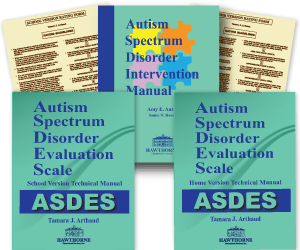|
Assessment and Intervention Resources |

 Be the first one to write a review
Be the first one to write a reviewby Tamara J. Arthaud
© 2014
| Buy a complete kit and save $50! | |||
| 04950 | ASDES Complete Kit | $248.00 | Add to Cart |
| Complete Kit Includes:ASDES School Version Technical Manual, ASDES School Version Rating Form (25), ASDES Home Version Technical Manual, ASDES Home Version Rating Form (25), and ASDES Quick Score (Download) | |||
| 04900 | ASDES School Version Technical Manual | $45.00 | Add to Cart |
| 04910 | ASDES School Version Rating Form (25) | $49.00 | Add to Cart |
| 04920 | Autism Spectrum Disorder Intervention Manual | $60.00 | Add to Cart |
| 04930 | ASDES Home Version Technical Manual | $45.00 | Add to Cart |
| 04931 | ASDES Home Version Rating Form (25) | $49.00 | Add to Cart |
| 04901D | ASDES Quick Score (Windows®)-Download | $50.00 | Add to Cart |
Software that has been downloaded may not be returned.
The Autism Spectrum Disorder Evaluation Scale (ASDES) is based on the most commonly recognized definition of Autism Spectrum Disorder (ASD) as defined by the American Psychiatric Association (APA) (2013) in the DSM-5™. It has school and home versions to document behavior observations in the school and residential environments. It is nationally standardized for ages 3 through 18 years of age.
The Autism Spectrum Disorder Evaluation Scale measures the characteristics typically associated with Autism Spectrum Disorder as described by the medical profession and observed by educators, psychologists, and psychiatrists. The Home Version provides doctors, therapists, and educators documentation and frequency of the characteristics observed in the home setting. The School Version allows educators to document observations of behavior in the school environment. Combining both versions provides a broader assessment of the child’s social, emotional, academic, and communication strengths and weaknesses across different environments. Both scales contribute valuable information to the identification process of children and youth with Autism Spectrum Disorder. The following functions are served by the instrument:
Characteristics and Components of the ASDES
The Autism Spectrum Disorder Evaluation Scale Quick Score computer program converts raw scores to standard scores and percentiles which makes scoring efficient and convenient.
SOFTWARE REQUIREMENTS